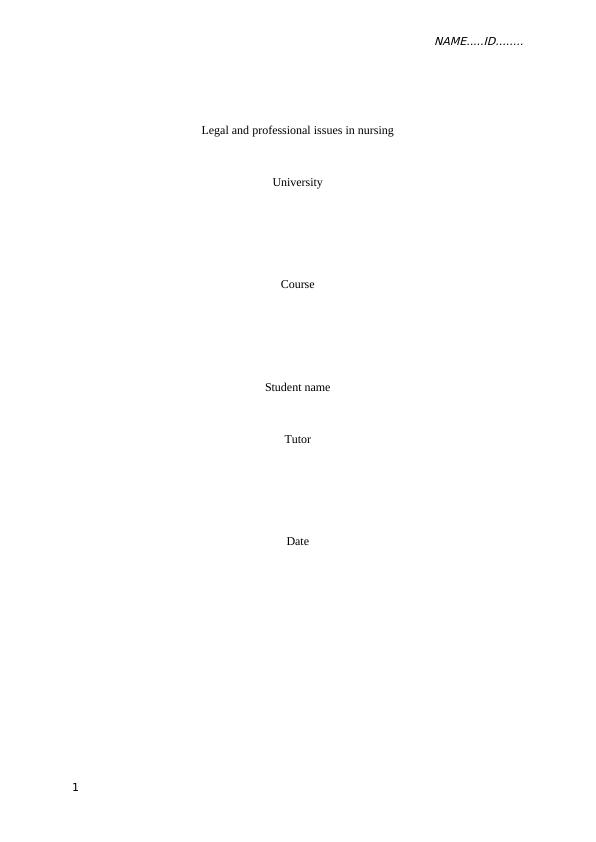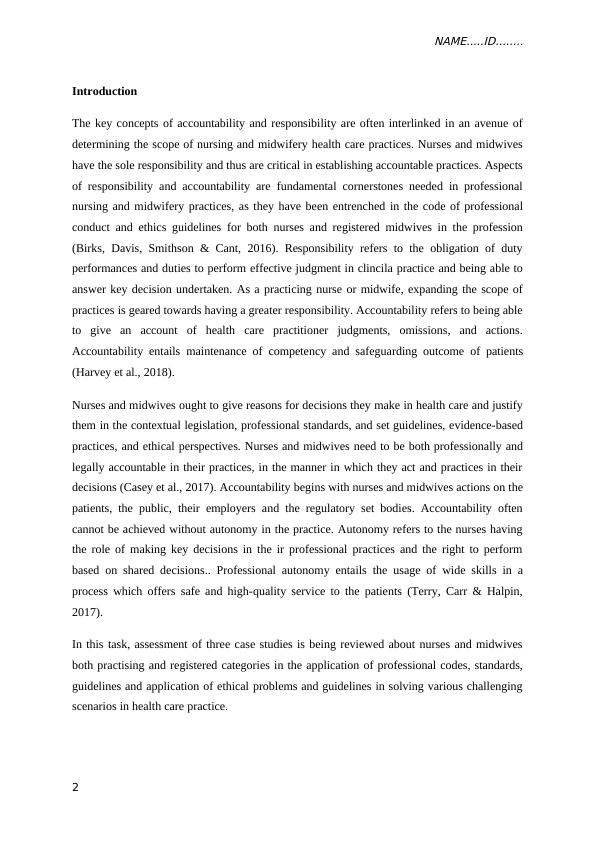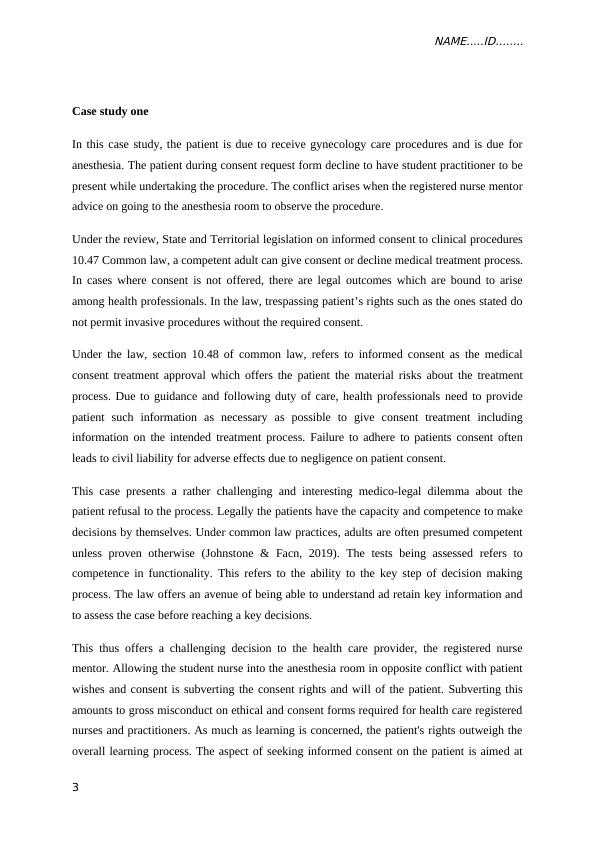Legal and Professional Issues in Nursing
Added on 2022-12-30
10 Pages3282 Words62 Views
NAME.....ID........
Legal and professional issues in nursing
University
Course
Student name
Tutor
Date
1
Legal and professional issues in nursing
University
Course
Student name
Tutor
Date
1

NAME.....ID........
Introduction
The key concepts of accountability and responsibility are often interlinked in an avenue of
determining the scope of nursing and midwifery health care practices. Nurses and midwives
have the sole responsibility and thus are critical in establishing accountable practices. Aspects
of responsibility and accountability are fundamental cornerstones needed in professional
nursing and midwifery practices, as they have been entrenched in the code of professional
conduct and ethics guidelines for both nurses and registered midwives in the profession
(Birks, Davis, Smithson & Cant, 2016). Responsibility refers to the obligation of duty
performances and duties to perform effective judgment in clincila practice and being able to
answer key decision undertaken. As a practicing nurse or midwife, expanding the scope of
practices is geared towards having a greater responsibility. Accountability refers to being able
to give an account of health care practitioner judgments, omissions, and actions.
Accountability entails maintenance of competency and safeguarding outcome of patients
(Harvey et al., 2018).
Nurses and midwives ought to give reasons for decisions they make in health care and justify
them in the contextual legislation, professional standards, and set guidelines, evidence-based
practices, and ethical perspectives. Nurses and midwives need to be both professionally and
legally accountable in their practices, in the manner in which they act and practices in their
decisions (Casey et al., 2017). Accountability begins with nurses and midwives actions on the
patients, the public, their employers and the regulatory set bodies. Accountability often
cannot be achieved without autonomy in the practice. Autonomy refers to the nurses having
the role of making key decisions in the ir professional practices and the right to perform
based on shared decisions.. Professional autonomy entails the usage of wide skills in a
process which offers safe and high-quality service to the patients (Terry, Carr & Halpin,
2017).
In this task, assessment of three case studies is being reviewed about nurses and midwives
both practising and registered categories in the application of professional codes, standards,
guidelines and application of ethical problems and guidelines in solving various challenging
scenarios in health care practice.
2
Introduction
The key concepts of accountability and responsibility are often interlinked in an avenue of
determining the scope of nursing and midwifery health care practices. Nurses and midwives
have the sole responsibility and thus are critical in establishing accountable practices. Aspects
of responsibility and accountability are fundamental cornerstones needed in professional
nursing and midwifery practices, as they have been entrenched in the code of professional
conduct and ethics guidelines for both nurses and registered midwives in the profession
(Birks, Davis, Smithson & Cant, 2016). Responsibility refers to the obligation of duty
performances and duties to perform effective judgment in clincila practice and being able to
answer key decision undertaken. As a practicing nurse or midwife, expanding the scope of
practices is geared towards having a greater responsibility. Accountability refers to being able
to give an account of health care practitioner judgments, omissions, and actions.
Accountability entails maintenance of competency and safeguarding outcome of patients
(Harvey et al., 2018).
Nurses and midwives ought to give reasons for decisions they make in health care and justify
them in the contextual legislation, professional standards, and set guidelines, evidence-based
practices, and ethical perspectives. Nurses and midwives need to be both professionally and
legally accountable in their practices, in the manner in which they act and practices in their
decisions (Casey et al., 2017). Accountability begins with nurses and midwives actions on the
patients, the public, their employers and the regulatory set bodies. Accountability often
cannot be achieved without autonomy in the practice. Autonomy refers to the nurses having
the role of making key decisions in the ir professional practices and the right to perform
based on shared decisions.. Professional autonomy entails the usage of wide skills in a
process which offers safe and high-quality service to the patients (Terry, Carr & Halpin,
2017).
In this task, assessment of three case studies is being reviewed about nurses and midwives
both practising and registered categories in the application of professional codes, standards,
guidelines and application of ethical problems and guidelines in solving various challenging
scenarios in health care practice.
2

NAME.....ID........
Case study one
In this case study, the patient is due to receive gynecology care procedures and is due for
anesthesia. The patient during consent request form decline to have student practitioner to be
present while undertaking the procedure. The conflict arises when the registered nurse mentor
advice on going to the anesthesia room to observe the procedure.
Under the review, State and Territorial legislation on informed consent to clinical procedures
10.47 Common law, a competent adult can give consent or decline medical treatment process.
In cases where consent is not offered, there are legal outcomes which are bound to arise
among health professionals. In the law, trespassing patient’s rights such as the ones stated do
not permit invasive procedures without the required consent.
Under the law, section 10.48 of common law, refers to informed consent as the medical
consent treatment approval which offers the patient the material risks about the treatment
process. Due to guidance and following duty of care, health professionals need to provide
patient such information as necessary as possible to give consent treatment including
information on the intended treatment process. Failure to adhere to patients consent often
leads to civil liability for adverse effects due to negligence on patient consent.
This case presents a rather challenging and interesting medico-legal dilemma about the
patient refusal to the process. Legally the patients have the capacity and competence to make
decisions by themselves. Under common law practices, adults are often presumed competent
unless proven otherwise (Johnstone & Facn, 2019). The tests being assessed refers to
competence in functionality. This refers to the ability to the key step of decision making
process. The law offers an avenue of being able to understand ad retain key information and
to assess the case before reaching a key decisions.
This thus offers a challenging decision to the health care provider, the registered nurse
mentor. Allowing the student nurse into the anesthesia room in opposite conflict with patient
wishes and consent is subverting the consent rights and will of the patient. Subverting this
amounts to gross misconduct on ethical and consent forms required for health care registered
nurses and practitioners. As much as learning is concerned, the patient's rights outweigh the
overall learning process. The aspect of seeking informed consent on the patient is aimed at
3
Case study one
In this case study, the patient is due to receive gynecology care procedures and is due for
anesthesia. The patient during consent request form decline to have student practitioner to be
present while undertaking the procedure. The conflict arises when the registered nurse mentor
advice on going to the anesthesia room to observe the procedure.
Under the review, State and Territorial legislation on informed consent to clinical procedures
10.47 Common law, a competent adult can give consent or decline medical treatment process.
In cases where consent is not offered, there are legal outcomes which are bound to arise
among health professionals. In the law, trespassing patient’s rights such as the ones stated do
not permit invasive procedures without the required consent.
Under the law, section 10.48 of common law, refers to informed consent as the medical
consent treatment approval which offers the patient the material risks about the treatment
process. Due to guidance and following duty of care, health professionals need to provide
patient such information as necessary as possible to give consent treatment including
information on the intended treatment process. Failure to adhere to patients consent often
leads to civil liability for adverse effects due to negligence on patient consent.
This case presents a rather challenging and interesting medico-legal dilemma about the
patient refusal to the process. Legally the patients have the capacity and competence to make
decisions by themselves. Under common law practices, adults are often presumed competent
unless proven otherwise (Johnstone & Facn, 2019). The tests being assessed refers to
competence in functionality. This refers to the ability to the key step of decision making
process. The law offers an avenue of being able to understand ad retain key information and
to assess the case before reaching a key decisions.
This thus offers a challenging decision to the health care provider, the registered nurse
mentor. Allowing the student nurse into the anesthesia room in opposite conflict with patient
wishes and consent is subverting the consent rights and will of the patient. Subverting this
amounts to gross misconduct on ethical and consent forms required for health care registered
nurses and practitioners. As much as learning is concerned, the patient's rights outweigh the
overall learning process. The aspect of seeking informed consent on the patient is aimed at
3

End of preview
Want to access all the pages? Upload your documents or become a member.
Related Documents
Law and Ethics in Health Care - Case Studylg...
|15
|4294
|29
Overview Registered Nurses Case Study 2022lg...
|11
|3626
|25
Legal and Professional Practice: Documentation and Informed Consentlg...
|8
|2193
|285
Nursing and Law - Assignmentlg...
|9
|1622
|204
Author's Note: Advancement in Healthcare Processeslg...
|15
|3790
|26
Nurses and Midwives Ethical and legal Accountabilities and Responsibilities Case Study 2022lg...
|10
|3500
|25
